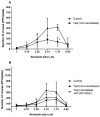Ability of Essential Oil Vapours to Reduce Numbers of Culturable Aerosolised Coronavirus, Bacteria and Fungi
- PMID: 35326856
- PMCID: PMC8944824
- DOI: 10.3390/antibiotics11030393
Ability of Essential Oil Vapours to Reduce Numbers of Culturable Aerosolised Coronavirus, Bacteria and Fungi
Abstract
Transmission of pathogens present in the indoor air can occur through aerosols. This study evaluated the efficacy of an evaporated mix of essential oils to reduce the numbers of culturable aerosolized coronavirus, bacterium and fungus. The essential oil-containing gel was allowed to vaporize inside a glass chamber for 10 or 20 min. Aerosols of a surrogate of SARS-CoV-2, murine hepatitis coronavirus MHV-1, Escherichia coli or Aspergillus flavus spores were produced using a collision nebuliser and passed through the essential oil vapours, then collected on a six-stage Andersen sampler. The six-stages of the impact sampler capture aerosols in sizes ranging from 7 to 0.65 µm. The number of culturable microbes present in the aerosols collected in the different stages were enumerated and compared to the number of culturable microbes in control microbial aerosols that were not exposed to the evaporated essential oils. After 10 and 20 min evaporation, the essential oils reduced the numbers of culturable aerosolized coronavirus by 48% (log10 reduction = 0.3; p = 0.002 vs. control) and 53% (log10 reduction = 0.3; p = 0.001 vs. control), respectively. The essential oils vaporised for 10 min, reduced the number of viable E. coli by 51% (log10 reduction = 0.3; p = 0.032 vs. control). The Aspergillus flavus spores were mostly observed in the larger aerosols (7.00 µm to 2.10 µm) and the essential oils vaporised for 10 min reduced the number of viable spores by 72% (log10 reduction = 0.6; p = 0.008 vs. control). The vapours produced by a gel containing naturally occurring essential oils were able to significantly reduce the viable numbers of aerosolized coronavirus, bacteria and fungal spores. The antimicrobial gel containing the essential oils may be able to reduce aerosol transmission of microbes when used in domestic and workplace settings.
Keywords: SARS-CoV-2 surrogate; aerosol; antimicrobial; essential oils.
Conflict of interest statement
Funding and in-kind contribution for this study was received from San Air. The funders had no role in the design of the study; in the collection, analyses, or interpretation of data; or in the writing of the manuscript.
Figures





Similar articles
-
Monitoring of bioaerosol inhalation risks in different environments using a six-stage Andersen sampler and the PCR-DGGE method.Environ Monit Assess. 2013 May;185(5):3993-4003. doi: 10.1007/s10661-012-2844-1. Epub 2012 Sep 7. Environ Monit Assess. 2013. PMID: 22955887
-
Applicability of a modified MCE filter method with Button Inhalable Sampler for monitoring personal bioaerosol inhalation exposure.Environ Sci Pollut Res Int. 2013 May;20(5):2963-72. doi: 10.1007/s11356-012-1204-6. Epub 2012 Sep 30. Environ Sci Pollut Res Int. 2013. PMID: 23054771
-
Enhancing bioaerosol sampling by Andersen impactors using mineral-oil-spread agar plate.PLoS One. 2013;8(2):e56896. doi: 10.1371/journal.pone.0056896. Epub 2013 Feb 27. PLoS One. 2013. PMID: 23460818 Free PMC article.
-
Volumetric assessment of airborne fungi in two sections of a rural indoor dairy cattle shed.Environ Int. 2004 Feb;29(8):1071-8. doi: 10.1016/S0160-4120(03)00103-X. Environ Int. 2004. PMID: 14680890
-
Strategies for the simultaneous collection of vapours and aerosols with emphasis on isocyanate sampling.Analyst. 1994 Jan;119(1):89-97. doi: 10.1039/an9941900089. Analyst. 1994. PMID: 8154600 Review.
Cited by
-
Mechanisms, Techniques and Devices of Airborne Virus Detection: A Review.Int J Environ Res Public Health. 2023 Apr 11;20(8):5471. doi: 10.3390/ijerph20085471. Int J Environ Res Public Health. 2023. PMID: 37107752 Free PMC article. Review.
-
Harnessing Non-Antibiotic Strategies to Counter Multidrug-Resistant Clinical Pathogens with Special Reference to Antimicrobial Peptides and Their Coatings.Antibiotics (Basel). 2025 Jan 9;14(1):57. doi: 10.3390/antibiotics14010057. Antibiotics (Basel). 2025. PMID: 39858343 Free PMC article. Review.
-
Antiviral Natural Products, Their Mechanisms of Action and Potential Applications as Sanitizers and Disinfectants.Food Environ Virol. 2023 Dec;15(4):265-280. doi: 10.1007/s12560-023-09568-x. Epub 2023 Oct 31. Food Environ Virol. 2023. PMID: 37906416 Review.
-
Antifungal activity and mechanism of action of natural product derivates as potential environmental disinfectants.J Ind Microbiol Biotechnol. 2023 Feb 17;50(1):kuad036. doi: 10.1093/jimb/kuad036. J Ind Microbiol Biotechnol. 2023. PMID: 37951298 Free PMC article. Review.
References
-
- Klepeis N.E., Nelson W.C., Ott W.R., Robinson J.P., Tsang A.M., Switzer P., Behar J.V., Hern S.C., Engelmann W.H. The National Human Activity Pattern Survey (NHAPS): A resource for assessing exposure to environmental pollutants. J. Expo. Anal. Environ. Epidemiol. 2001;11:231–252. doi: 10.1038/sj.jea.7500165. - DOI - PubMed
Grants and funding
LinkOut - more resources
Full Text Sources
Molecular Biology Databases
Miscellaneous

